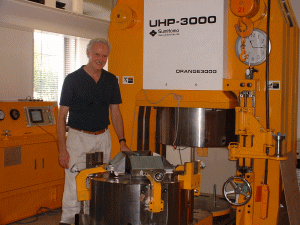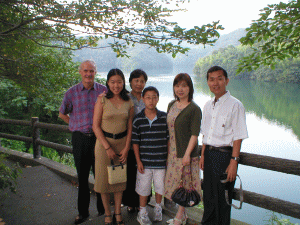 |
Professor Ian Jackson, from the Research School of Earth Sciences, Australian
National University spent three months from the end of May in Matsuyama
as a guest of GRC. His principal research interests are in the laboratory
measurement of the physical properties of rocks and minerals and the application
of such information to the structure and processes of the Earth's deep
interior. The measurement of elastic wave speeds at both very high (ultrasonic)
and low (seismic) frequencies has been a major focus of Professor Jackson's
recent work. High-frequency ultrasonic techniques developed by Li and others
at Stony Brook have recently been successfully implemented at the GRC for
measurement of elastic wavespeeds on small specimens of high-pressure silicate
minerals at high pressure in multi-anvil high-pressure apparatus. This
growing interest in ultrasonic interferometry in the GRC was part of the
motivation for Professor Jackson's visit. Through interaction with Higo-san,
Irifune-san and Inoue-san, he sought to establish a deeper understanding
of the key aspects of the new 'transfer-function' method.
Another major commitment was the preparation and presentation in late
July of a two-day lecture course entitled Elasticity and Anelasticity of
Earth Materials - Theoretical Background, Laboratory Measurements and Selected
Seismological Applications, along with a research seminar Laboratory measurements
of seismic wave speeds and attenuation in olivine.
He also found some time to continue with his personal research work on
seismic wave attenuation in upper-mantle materials, working with ANU colleagues
Faul and Fitz Gerald on the revision of two major manuscripts describing
laboratory measurements of attenuation in melt-bearing olivine and on some
calculations for a third manuscript describing the seismological application
of such laboratory work. Professor Jackson reports having had a productive
and enjoyable stay in Matsuyama - attributable he says to 'the warm hospitality,
willing assistance of staff and students, and the excellent facilities
of the GRC'. He describes Matsuyama as 'a pleasant, utterly unpretentious,
somewhat provincial environment with a sub-tropical summer climate - reminiscent
of the Brisbane of my childhood'. Away from work, 'living in an apartment
a few km off-campus, commuting by bicycle, shopping locally for essentials,
studying the Japanese language, and swimming for exercise at the nearby
Community Center combined to make for a varied and interesting experience
of the Japanese way of life'.

Dr. Yanbin Wang is a Senior Research Scientist at the University of Chicago, visiting GRC from July to September, 2003. He is the lead scientist of the large-volume press synchrotron facility at Center for Advanced Radiation Sources' (CARS) Sector 13 at the Advanced Photon Source (APS), the U.S. third-generation synchrotron source at Argonne National Laboratory.
Dr. Wang's research interests are primarily related to mineral physics.
Using the multi-anvil apparatus and synchrotron X-radiation, his research
areas range from physical properties of high-pressure minerals (including
P-V-T equations of state, acoustic velocities, viscosity of melts, and
rheology of solids) to crystal structure and crystal chemistry under conditions
corresponding to the deep interior of the Earth. He also conducts modeling
on composition and mineralogy for the Earth's mantle, in collaborating
with scientists in other fields. He is currently involved with two major
technical developments at the APS: the Deformation DIA (D-DIA) and a high-pressure
tomography apparatus.
While visiting GRC, Dr. Wang gave a one-and-a-half day lecture series
entitled "P-V-T Equations of State: Fundamentals, Practices, and Applications"
and presented a seminar "Towards high-pressure rheology: Deformation
experiments in the D-DIA with High-Resolution Monochromatic Diffraction".
He enjoys interacting with the faculty, staff, and students at the GRC
and is collaborating with them in analyzing synchrotron data and synthesizing
samples of high-pressure minerals for future rheological studies in the
D-DIA. He is looking forward to joining the synchrotron experiments at
Spring-8 in the coming beam time in September.
Dr. Wang's wife, Mei, and two children Vania (16 years old) and Erik
(11) had a wonderful time during their one-month stay in Matsuyama. They
enjoyed fishing and picnicking on Kashima island with GRC faculty, staff
and students. They also enjoyed taking Japanese classes, walking around
Matsuyama castle, bathing in Dogo Onsen, and, of course, the food! They
had a rare opportunity to visit Kyoto, Nara, and Hiroshima during the Obon
season in August. The visit to Hiroshima Peace Memorial was an especially
unforgettable experience, which will benefit the children for the lifetime.
In addition, Vania had a unique opportunity to help GRC students practice
conversational English in her informal evening classes. Now back in Chicago,
Mei and the children would like to express their gratitude to all the faculty,
staff, and students of GRC for the warm hospitality: Hontoni Doumo Arigatou
Gozaimashita!


